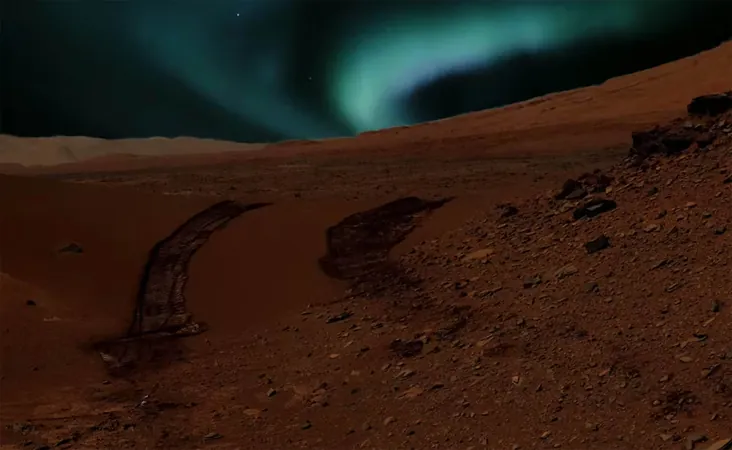
Mars Illuminated: First-Ever Visible-Light Auroras Captured by Perseverance Rover!
2025-05-16
Author: Yu
In an astonishing cosmic event, NASA’s Perseverance rover has unveiled stunning auroras dancing in the Martian sky! This groundbreaking achievement marks the very first time a glowing green veil has been photographed from the surface of another planet.
Captured on March 22, 2024, this awe-inspiring display followed a powerful solar eruption that struck Mars just days prior. These mesmerizing images not only validate scientific predictions about Martian auroras but also suggest that they could one day rival Earth’s spectacular northern lights.
The Cosmic Convergence
The saga began one week earlier, on March 15, when the sun unleashed a ferocious X-class flare along with a massive coronal mass ejection (CME). This turbulent plasma cloud, rushing outward at millions of kilometers per hour, carried a multitude of solar energetic particles (SEPs) that held the potential to ignite an aurora.
While Earth’s polar auroras glow due to charged particles channeled by our magnetic field, Mars lacks such a protective layer. Instead, the entire nightside atmosphere can illuminate during significant solar events, leading scientists to question whether this celestial glow could be captured in visible light.
A Collaborative Effort
NASA's MAVEN orbiter had previously detected that SEPs can create vast, diffuse auroras in the Martian atmosphere. Scientists hypothesized that intense SEP storms could excite oxygen atoms to emit a distinct green light, similar to what we see on Earth.
To seize this opportunity, the Perseverance team geared up with two instruments: the Mastcam-Z imager and the SuperCam spectrometer. Postdoctoral researcher Elise Knutsen at the University of Oslo emphasized that this discovery paves the way for new auroral research and offers thrilling prospects for future astronauts on Mars.
Perfect Timing is Key
Space weather experts at NASA’s Moon to Mars Space Weather Analysis Office meticulously tracked solar flares and utilized advanced computer modeling to predict when a CME would strike Mars. The right storm was crucial, one that could infuse the Martian atmosphere with a flurry of charged particles.
An alert regarding the March 15 CME reached Christina Lee at UC Berkeley, who promptly disseminated a Mars Space Weather Alert Notification across all active spacecraft—ensuring that both Perseverance and MAVEN could anticipate the celestial impacts.
Aurora Captured in Action
Just two days after the CME blasted Mars, Perseverance turned its gaze to the shadowy sky. The SuperCam’s spectrometer detected a strong spike at 557.7 nm—exactly the wavelength responsible for Earth’s green auroras. Meanwhile, the Mastcam-Z recorded delicate emerald curtains swaying overhead.
Data from MAVEN and ESA’s Mars Express corroborated the presence of high-energy particle torrents at that moment, confirming the origin of the mesmerizing light show. Shannon Curry, principal investigator for MAVEN, celebrated the pivotal collaboration that led to this monumental discovery.
Understanding Mars' Luminescence
Unlike Earth, where auroras concentrate around magnetic poles, Mars, stripped of its global magnetic field billions of years ago, displays auroras that can span the entire planet's atmosphere during intense solar events. These new findings demonstrate that oxygen atoms in Mars’ thin atmosphere can indeed emit visible green light when influenced by solar debris.
Future Implications for Space Exploration
Monitoring Martian auroras is more than just a scientific curiosity; it has profound implications for future space travelers. Understanding SEPs is crucial as they pose a radiation risk to both electronic systems and human health. By predicting these storm events, we can offer potential shelter options for explorers.
As the sun approaches its maximum in 2025, astronomers are bracing for more CMEs, with exhilarating possibilities for celestial displays on Mars. Perseverance and MAVEN remain vigilant, transforming potential hazards into a window into space weather—and, perhaps, an unforgettable experience for the first explorers to set foot on the Red Planet.



 Brasil (PT)
Brasil (PT)
 Canada (EN)
Canada (EN)
 Chile (ES)
Chile (ES)
 Česko (CS)
Česko (CS)
 대한민국 (KO)
대한민국 (KO)
 España (ES)
España (ES)
 France (FR)
France (FR)
 Hong Kong (EN)
Hong Kong (EN)
 Italia (IT)
Italia (IT)
 日本 (JA)
日本 (JA)
 Magyarország (HU)
Magyarország (HU)
 Norge (NO)
Norge (NO)
 Polska (PL)
Polska (PL)
 Schweiz (DE)
Schweiz (DE)
 Singapore (EN)
Singapore (EN)
 Sverige (SV)
Sverige (SV)
 Suomi (FI)
Suomi (FI)
 Türkiye (TR)
Türkiye (TR)
 الإمارات العربية المتحدة (AR)
الإمارات العربية المتحدة (AR)